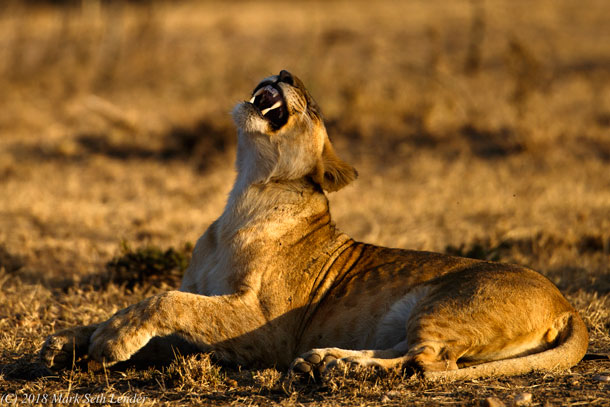Field Note: Night Moves
Published: October 12, 2018
By Mark Seth Lender

The hunt begins. (Photo: Mark Seth Lender)
Our Explorer-in-Residence Mark Seth Lender elaborates on the huffing sound African lions make, as depicted in his essay "Night Moves", and on how alternative forms of communication can contribute to a social group's success.
African lions may hunt at any intersection of hunger and opportunity. But in a fur coat on a hot day, night is certainly more comfortable. And there are strategic advantages. A lion’s roar, which ends in a short series of vocal plosives carries very far. From a distance, it’s like a cough followed by a kind of huffing. It can mean many things (determined in part by whether it is a male or female doing the roaring) but the one most interesting to me is when vocalization is a major part of the strategy of a hunt.
In the daytime, lions rely almost entirely on visual cues for coordination. They are both quite subtle and remarkably effective. When the light starts to fail, despite superior sight as compared with their prey, lions include a unique repertoire of meaningful calls which all by themselves will do the job and then some.
In the dark this sound language of lions is a form of communication analogous to what Sign Language can be to us. Alternative languages including sign, and the whistling languages such as Sfyria in the Greek Islands, can be employed by entire communities even when the majority of speakers have no auditory deficit. I lived for many years on the island of Martha’s Vineyard. Owing to its high degree of isolation in the past, genetically based congenital deafness had become endemic, at a rate of many orders of magnitude beyond that of the mainland population.
Beginning in the 18th century a sui generis system of sign language evolved, Martha’s Vineyard Sign Language (MVSL). It was eventually spoken by virtually the entire population of the Island, both hearing and deaf. It was especially for fisherman. Fishing boats, where many worked, were extremely loud, and sign presented certain advantages. I wrote my masters thesis in Anthropology on commercial fishing, working on a wood-hulled boat out of Menemsha for my fieldwork. We were rigged for trawling and for deep-sea lobstering, and I can testify to the roar of the engine and the main winch. A man on the work deck could not hear a man at the bows. It was a dangerous and unpredictable environment and our hand signals to each other were a pale substitute for MVSL.
The repertoire of gesture and sound available to lions is a matter of biology. The way to use these biological gifts, however, has to be learned by watching others, by experience, and by the ability to correct past mistakes.
Hear and read the essay, "Night Moves"
Back to Mark Seth Lender Field Notes
Living on Earth wants to hear from you!
Living on Earth
62 Calef Highway, Suite 212
Lee, NH 03861
Telephone: 617-287-4121
E-mail: comments@loe.org
Newsletter [Click here]
Donate to Living on Earth!
Living on Earth is an independent media program and relies entirely on contributions from listeners and institutions supporting public service. Please donate now to preserve an independent environmental voice.
NewsletterLiving on Earth offers a weekly delivery of the show's rundown to your mailbox. Sign up for our newsletter today!
 Sailors For The Sea: Be the change you want to sea.
Sailors For The Sea: Be the change you want to sea.
 The Grantham Foundation for the Protection of the Environment: Committed to protecting and improving the health of the global environment.
The Grantham Foundation for the Protection of the Environment: Committed to protecting and improving the health of the global environment.
 Contribute to Living on Earth and receive, as our gift to you, an archival print of one of Mark Seth Lender's extraordinary wildlife photographs. Follow the link to see Mark's current collection of photographs.
Contribute to Living on Earth and receive, as our gift to you, an archival print of one of Mark Seth Lender's extraordinary wildlife photographs. Follow the link to see Mark's current collection of photographs.
 Buy a signed copy of Mark Seth Lender's book Smeagull the Seagull & support Living on Earth
Buy a signed copy of Mark Seth Lender's book Smeagull the Seagull & support Living on Earth

